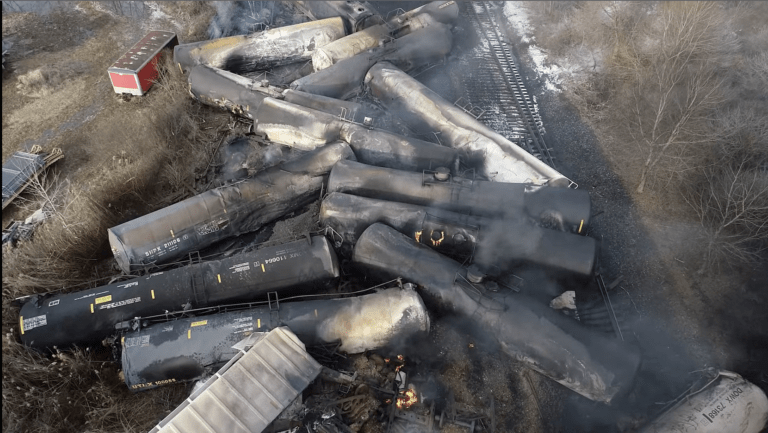What the Ohio Train Derailment and the BP Oil Spill Have in Common
Thirteen years after the BP oil spill, lessons learned from this disaster could help save lives in the aftermath of the East Palestine train disaster.

Image of the Ohio train derailment published by the NTSB (Public Domain).
By Riki Ott, Director of the ALERT Project.
The Northern Suffolk (NS) disaster response in East Palestine, Ohio, is playing out with frustrating similarity to the BP Deepwater Horizon oil spill. Given that both are hazardous waste operations under emergency response scenarios, the BP disaster is predictive of much of what is likely to happen with the NS disaster.
In both cases, open burns released tons of hazardous substances as enormous clouds of ultrafine particulate matter visible as “smoke.” The tiny particles were lofted by intense heat, transported by air currents far and wide, as they hitch-hiked on dust particles and rain droplets, before eventually settling down. In the BP disaster, the particles spread over 80 miles inland. In southeast Louisiana, oil spill particles and benzene created a public health risk in rural and coastal regions during the five months of peak emissions.
In both disasters, people showed signs and symptoms of exposure at levels of pollutants below what is supposedly “safe.” The early warnings of exposure – a cough, difficulty breathing, dizziness, nausea, headaches, and skin rashes – are now known to be linked with long-term debilitating illnesses and cancers. With early intervention and proper diagnosis of oil-chemical exposures, long-term harm can be reduced or prevented.
Unfortunately, early intervention and proper diagnosis for disaster responders and exposed residents is not what happened with the BP disaster, and it is not happening now with the NS disaster. But it could be.
The U.S. National Response Team, which responds to emergencies involving hazardous substances in disasters of national significance, recommends health monitoring and surveillance of exposed individuals and the exposed population to accurately assess health risk. The NRT has found environmental monitoring alone insufficient, especially for “uncertain exposures” from mixtures of chemicals, as occurred in both the BP and NS disasters.
Currently what is happening in East Palestine are surveys, lots of surveys to the point where residents are getting “survey fatigue.” However, it may be years before results are known while the window for early intervention is closing.
What would be more useful to both exposed individuals and researchers are holistic health surveys that point to underlying systems affected rather than superficial symptoms. One such survey, the Quick Environmental Exposure and Survey Inventory or QEESI, is noninvasive and produces immediate tangible results that can be used by an individual’s healthcare providers for proper diagnosis and early treatment to possibly reduce or prevent long-term illnesses. For researchers, the surveys provide insight into the geographic scope of harm and remediation measures.
Health monitoring and surveillance of workers and exposed residents should be required in all emergency responses to disasters involving hazardous substances. QEESI should be the norm for disasters that involve uncertain exposures. Your support will help ALERT make this happen!
